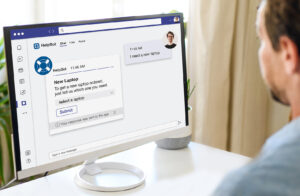Did you know that more than 1 million organizations use Microsoft Teams as their primary messaging platform, according to Business of Apps? In a market that is dominated by competitive software products, that’s pretty significant.
Microsoft Teams is a communication and collaboration platform, but it also has the potential to be so much more with dedicated apps and plugins. You can even expand it by installing a Microsoft Teams ticketing system.
Ready to streamline your internal service desk? We’ve put together a guide on how to get started.
Getting Started with a Microsoft Teams Ticketing System
We’ll get to the benefits of setting up an IT ticketing system with Microsoft Teams in a bit. But first, let’s start with the basics. We assume that you already have Microsoft Teams online set up. If you don’t, definitely do that before following these steps.
1. Find an IT Service Desk that Integrates with Teams
There are various IT service desk options that offer Teams add-ons and plugins for IT ticketing. Most of these come from third-party providers (not Microsoft), but only one provides a native Teams experience: Tikit, a M365 service desk solution. Tikit was designed to look, feel and operate as part of Microsoft Teams.
Because of this, end users can request help in Teams, and analysts can track, resolve and route tickets—even take advantage of a Teams-like feature called groups—via Microsoft Teams web, desktop and mobile app; Tikit web app and Outlook email.
Define Functionality Needs
What functionality does your team need from its ticketing system? Consider the questions below:
• Do you need to manipulate (create, escalate and close) tickets directly from a Microsoft Teams chat window or email?
• Do you want your solution to attach Teams’ chats to a ticket as part of its activity history?
• Would you like to use artificial intelligence (AI) to streamline ticketing and/or include conversational features in the ticketing process?
• What kind of training materials exist for the system? A company that offers a robust library of resources or training could be helpful.
2. Install in Stages
Install the solution with a small team first, preferably among the service desk, if possible.
An IT ticketing system is critically important to internal operations. Because of this, testing it in a smaller environment could help you see where to adjust or how to prevent disruption before rolling it out to the whole company.
3. Train Your Service Desk Team on the New System
Service desk staff are the core users and front line of this solution, so they should have a sense of ease using the platform. Have them review related learning materials or a “how to get started” guide. Better yet: let them manage end user training for the new system along with ongoing communications. This way end users are more likely to feel comfortable and connected to the service desk team.
Since Teams is so intuitive and employees are likely already using it, this might go quickly!
4. Test Workflows
Once your team is up to speed, thoroughly test ticketing workflows before rolling them out.
A limited pilot release makes it easier to identify, track and resolve issues with workflows, routing and any automated processes. This way you can clear any blocks and keep the ticket queue moving.
5. Deploy
If everything is running smoothly, you’re ready to roll out the ticketing system across your organization. Make sure you set up a process to gather feedback, whether by designating a go-to person for questions, roping in managers or sending out surveys.
Why Use a Microsoft Teams Ticketing System?
There are many benefits to using a ticketing system attached to Microsoft Teams, including:
Time and Resource Efficiency
With a Microsoft Teams-compatible ticketing system, analysts don’t need to flip between separate software tools to manage tickets. They can work tickets and complete other IT tasks in the Microsoft 365 ecosystem.
Maximizes Investment
You’ve already invested in Microsoft 365, which includes Microsoft Teams. Why not make the most of this investment? A Teams-friendly IT ticketing system connects to other Microsoft applications, so you’ll also be able to leverage tools like PowerBI, Intune, Power Automate and more in your ticketing experience.
Centralized Workspace
When Microsoft Teams and an IT service desk work together, you can centralize contextual information about tickets. Instead of transferring conversation notes from Teams into a third-party ticketing system, your analysts can engage with end users, create and resolve tickets, and organize ticket views and workspace without leaving Teams.
Teams’ cloud functionality also makes it possible to reach end users wherever they are working—an important feature when supporting remote service desk workers.
Simplify Your Service Desk Operations
If you’re in the market for a Microsoft-exclusive solution, consider Tikit. Because it’s built for Microsoft Teams and integrates with other Microsoft products, you can be confident it will complement existing Teams workflows.




